| |
 Henry
Thomas 'Harry' Anable Henry
Thomas 'Harry' Anable
The
first name on the Dry Drayton World War I
memorial (above), Harry Anable,
was my great-great-uncle, the younger
brother of my great-grandmother Alice Anable and an
uncle of my grandmother Winifred
Ellen Reynolds. Here he is on the 1911
census.The
Cambridge Independent Press
recorded on 12th March 1915 that 19 year
old Harry Anable had enlisted that week.
He signed up as a Private in the 11th
Battalion of the Suffolk Regiment, the
renowned Cambridge Battalion. He was
killed on the first day of the Battle of
the Somme, 1st July 1916. He was just 19
years old.
Harry Anable was one of the first
soldiers to go over the top that day, and
one of the first to die. The 11th
Suffolks attacked at 7.32 am, and
suffered terrible losses. They attacked
with the 10th Bn of the Lincolnshire
Regiment, the Grimsby Chums, at a place
known as Sausage Valley, just south of La Boisselle, to the
east of the town of Albert.
|
|
|
Malcolm Brown, in The
Imperial War Museum Book of the Somme,
records that ...within two minutes of
zero hour, before they had cleared the
front trench, they had been raked by
machine-gun fire. The Lincolnshires lost
15 officers and 462 other ranks, the
Suffolk battalion 15 officers and 512
other ranks. An artillery officer who
walked the ground later found 'line after
line of dead men lying where they had
fallen'.
Chris McCarthy, in The
Somme Day-by-Day, notes that the 60,000 pound mine at
Lochnagar south of La Boisselle
exploded two minutes before zero hour: There
was no surprise, and , ten minutes after
zero, 80 per cent of the men in the
leading battalion of the first column
were casualties.... The 10th Lincolns
with 11th Suffolks following received
machine-gun fire from Sausage Valley, La
Boisselle and the German front line
trench, which inflicted severe
casualties. On the extreme right a party
which tried to storm Sausage Redoubt was
burnt to death by flame-throwers and the
Lincolns and the Suffolks were unable to
cross the 500 yards of no man's land.
William Brooks and Allan
Tack, also on the memorial, died
alongside Harry that sunny morning. None
of their bodies were ever identified, and
they are remembered, along with almost
75,000 other young men whose bodies were
lost on the Somme, on the Memorial to the
Missing at Thiepval in northern
France (right). He is also
remembered on the Dry Drayton parish war
memorial and on the memorial boards in St
George's chapel in Ely Cathedral.
|
|
 |
Harry Anable's big sister Alice is
shown holding me on her lap on the day I was
christened in 1961.
Percy Anable
Percy Anable was Harry's older brother, my
great-great-uncle, a younger brother of my
great-grandmother Alice
Anable and an uncle to my grandmother Winifred Ellen
Reynolds, my mother's mother. Here he is with Alice on the 1891
census. He joined the 1st Battalion of the
Suffolk Regiment, and his
medal record shows that he arrived in France on
the 24th March 1915, when he would have been 29
years old. This probably means that he took part
in the Second Battle of Ypres and the Battle of
Loos. However, he appears to have avoided the
long, relatively quiet occupation of Salonika in
Greece, because his medal record suggests that he
was discharged from service on the 31st October
1915, as the Battalion was setting sail from
Marseilles. He survived the War.
William Anable
William Ernest Anable was Harry' and Percy's
older brother, my great-great-uncle, an older
brother of my great-grandmother Alice
Anable and an uncle to my grandmother Winifred Ellen
Reynolds, my mother's mother. Here he is with Alice on the 1891
census. He enlisted as a Sapper with the Royal
Engineers, and his medal record notes that he
landed in France on the 21st May 1915, when he
would have been 35 years old. He survived the
War.
Frederick Cannon
Frederick Cannon was my great-uncle, the
husband of Catherine
Cornwell who was the older sister of my
grandfather Edmund
Stanley Cornwell, my mother's father. His WWI
service records survive. His full name was
Frederick George Cannon. He signed up to the
Queens Royal West Surrey Regiment at Bedford on
the 19th October 1916, in the last days of the
Battle of the Somme. He was 19 years 1 month old
and 5 feet 9 inches tall. His chest measurement
girth when fully expanded was 33 inches. His
address was Butchers Yard, Offley, Hitchin,
Herts. Frederick had to wait until July 1917
before he was called to depot at Abbeville on the
Somme, and then in 1918 he was posted back in
England, and transferred to the Royal Army
Medical Corps. He survived the War. He remained
in the forces until 1920. Catherine Cornwell
married Frederick George Cannon on the 30th
August 1919 at Hertingfordbury, Hertfordshire.
Clarence Charles Cornwell
Clarence Charles Cornwell was my great-uncle, the
older brother of my grandfather Edmund
Stanley Cornwell, my mother's father. Here he is with Edmund
Stanley on the 1911 census. Charles enlisted as a
private soldier with the Cambridgeshire Regiment,
but was transferred to become a Lance-Corporal in
the Military Foot Police. His medal record shows that he
landed in France on the 14th February 1915, when
he was 29 years old. He survived the War, and
remained in the forces, joining the Grenadier
Guards. My mother remembers him visiting her
family in uniform when she was a child in the
late 1930s.
 Herbert
Cross Herbert
Cross
Herbert Cross is also remembered on the City of
Ely war memorial. He was my great-great-uncle,
the younger brother of my great-grandmother Sophia Cross, and an uncle of my
grandmother Phyllis Alice Page, my father's
mother. Here he is with Sophia
on the 1891 census when Herbert was 11 months
old. Herbert's medal record shows that he signed
up as a private soldier with the 11th Suffolks -
that is to say, he signed up after the War began.
As the Official History of the Suffolk Regiment
records, At the outbreak of War, men of
Cambridgeshire and the Isle of Ely who enlisted
for infantry were generally sent to the depot of
the Suffolk Regiment at Bury St Edmunds. By the
end of August, however, it was found impractible
to accomodate any more recruits at Bury... From
September 5th recruits instead of going to Bury
were accordingly retained in Cambridge, being
billetted in the Corn Exchange... within a few
days the numbers had swollen to three hundred,
the men being consequently transferred to the
boys' county school. When I attended this
school, now the Cambridge High School for Boys,
sixty years later, the temporary huts installed
to accomodate the recruits were still in use as
classrooms. At last, on September 25th the
Cambridgeshire Service Battalion, without
regiment or number, was an accomplished fact, and
three months later became the 11th Suffolk
Regiment.
The Official History of the Suffolk
Regiment continues The 11th Battalion
remained in Cambridge until May 19th 1915, when
it was sent up to Yorkshire, a large crowd
assembling at the station to give parting cheers.
At one point the 11ths were intended to take part
in the action at Galipolli, but the retreat from
Suvla Bay by allied forces put paid to this idea.
Instead, it appears that the 5th Suffolks, who
had taken part in the assault on Galipolli and
suffered terrible losses, were reinforced from
other Suffolk Regiment batallions, and so,
probably before the end of 1915, Herbert Chapman
Cross had been transferred to the 5ths, and was
soon engaged in the defence of the Suez Canal in
northern Egypt.
With the
War in the east turning in the Allies' favour, on
1st February the Battalion left Egypt for
Palestine. In April, they took part in the short
but furious Second Battle of Gaza. Patrick
Ashton's book Remembering Ely: a history of
Ely's war memorial and men of the Great War
(2018) records that Herbert was wounded on 9th
April. The source for this information may be the
Suffolk Regiment records at Bury St Edmunds. The
next mention we have of Herbert is his death on
October 18th 'from wounds'.
Was it the
injuries of 9th April that led to Herbert's
death, or had he recovered from them and returned
to the battalion? It seems that April's injuries
were likely to blame, for after the Second Battle
of Gaza the Battalion spent time at rest in an
encampment by the sea, and then behind the Gaza
line providing working parties for filling
sandbags. During the third week of June, the
Official History of the Suffolk Regiment records,
the battalion moved to Samson's Ridge, the
most prominent feature in that Sector, and
offering an extensive view of the country beyond
Gaza. Every afternoon the white houses of that
town caught the sun, making them look like fairy
dwellings to sand-weary eyes. The battalion
was then in training behind the lines until being
issued with helmets on 25th October for what
would turn out to be the Third Battle of Gaza,
but Herbert had, of course, been dead a week by
then. It was not possible to repatriate the
wounded from Palestine and Mesopotamia in the
same way as it was from northern France, so
Herbert may have spent all this time in a field
hospital in Gaza.
He was
buried in the Gaza War Cemetery in what is now
part of the Palestinian State. Unfortunately, the
cemetery, though well-maintained, is currently
not visitable from the West. He is remembered on
the City of Ely war memorial and on the memorial
boards in St George's chapel in Ely Cathedral,
although his name is curiously omitted from the
Holy Trinity parish war memorial, also in Ely
Cathedral.
Frederick Harrall
Frederick Harrall was the oldest son of Walter
Harrall, the brother of my
great-great-grandmother Mary Ann Waters née
Harrall. He was my first cousin thrice removed.
He lived at 3 Dairy Farm Cottages, Lower Higham,
Kent. Frederick was a gunner in the Royal Field
Artillery, later being promoted to tank corporal.
His medal record suggests that he fought in the
Middle East. He survived the War, and appears on
the Roll of Honour in St Mary's church, Higham,
Kent.
John 'Jack' Harrall
Jack Harrall was the second son of Walter
Harrall, the brother of my
great-great-grandmother Mary Ann Waters née
Harrall. He was also my first cousin thrice
removed. Jack was a private in the Kings Royal
Rifles. His medal record shows that he arrived in
France on 28th April 1915. He survived the War,
and appears on the Roll of Honour in St Mary's
church, Higham, Kent.
Frederick Knott
Frederick Knott was my great-great-uncle. He was
the younger brother of my great-grandfather
William Knott, who was the father of my
grandfather Vincent Helgia Knott, my father's
father. Frederick Knott was a professional
soldier, and his service record has survived. He
signed up to the Royal Artillery on March 15th
1895 at Dover Castle in Kent. He was 22 years and
10 months old. His height was measured as 5 feet
6 and 3/4 inches. He weighed 133 lbs. His chest
measurement was 33 inches, increasing to 35
inches when fully expanded. His complexion was
fair, his eyes blue-grey, his hair light brown
and his religion C of E. He had a small scar on
his right hand, and a tattoo on his left fore
arm. His next of kin was his father, George
Knott, of 58 Grange Road, Strood, Kent.
Frederick was in service for more than 22 years,
almost entirely in India. He began his military
career as a gunner, soon rising to Corporal. But
in 1904, for reasons unexplained, he underwent a
trial and was demoted to gunner. He fought in the
North West Frontier expedition to the Punjab in
the 1890s, and then spent much of the next twenty
years garrisoned in India. In 1915 he formed part
of the Eastern Mediterranean Expeditionary Force
to Mesopotamia, the modern Iraq. His medal record shows that he
arrived in area 5G (Mesopotamia?) on the 29th
August 1915. He was discharged as physically
unfit on the 26th April 1917. He was 45 years
old.
These are some surviving pages of
his service record:
     
 Joseph
Mansfield Joseph
Mansfield
A distant relative of mine: Joseph's grandmother
Mary Mansfield was a cousin of my
great-great-grandmother Eliza Mansfield, making
him my third cousin twice removed. But Mary and
Eliza were children together in the St Ives Union
Workhouse on the
night of the 1851 census, which gives these
two strands of the family a special bond. The
Mansfields, from Needingworth in Huntingdonshire,
are notable, not to say notorious, for producing
generation after generation of large families
while rarely bothering to marry.
At the time of the 1911 census,
Joseph was a Private in the 2nd Battalion of the
Bedfordshire Regiment stationed at Hamilton in
Bermuda in the West Indies. He was killed in
action near Ypres on the 19th April 1915, when he
was 26 years old. He is remembered on the Menin
Gate Memorial to the Missing, as well as on the
Needingworth village memorial and the
Holywell-cum-Needingworth parish memorial.
 Arthur Page Arthur Page
 |
|
There are two Pages on the
City of Ely WWI memorial, the brothers Arthur and Herbert. Arthur Page was my
great-grandfather, the father of my
grandmother Phyllis
Alice Page, my
father's mother. Here he is on the 1911
census. Arthur was a Serjeant in the 2nd
Battalion of the Suffolk Regiment, and
his medal record shows that
he arrived in France on the 26th January
1915.
The 2nd Battalion spent
their first winter and spring bogged down
in the trenches of the Vierstraat area of
Flanders, before being returned to Billet
at Westoutre on 11th April. They spent
the latter part of the spring building
the network of trenches in the Ypres
salient,and then on June 16th they were
part of the force which attacked and
consolidated its hold in V Wood and
Sanctuary Wood to the east of Ypres. It
seems that the Battalion came under what
were the first prolonged and sustained
gas attacks by the Germans on British
troops. During July they returned to
billet in Ypres again, but spent the rest
of the summer consolidating the hold on
the splendidly named Spoil Bank and
Bellyache Wood (see photograph, below
right), again to the west of Ypres.
In general, the 2nd Suffolks
seem to have spent an uneventful 1915 in
Flanders, with few casualties, except for
one major incident when, on September
8th, the battalion sustained more than a
hundred deaths trying to capture a crater
in Sanctuary Wood. Shortly after this,
Arthur's brother Herbert was injured, and
returned to England. He rejoined the
Battalion at the start of 1916, when they
were moved south towards St Eloi. Shortly
after arriving in the area, Arthur's
brother Herbert was killed.
|
In June 1916, the 2nd
Suffolks were removed completely from the
fighting and returned to depot at St Omer
for training in open warfare. They did
not know it, but the Generals were
preparing for the Big Push, designed to
distract the Germans from their assault
on Verdun. It would be known as the
Battle of the Somme. On July 1st, the
first day of the battle, the 2nd Suffolks
set out from St Omer for the Somme.
They arrived at the front on
July 8th, and were placed in reserve, and
then on July 14th they were moved into
the southern end of Caterpillar Wood, to
the east of Albert. Not far off, on July
18th, the Germans attacked and, at great
cost to them, overran Delville Wood and
part of the town of Longueval. Two
companies of the 2nd Suffolks were sent
to support the counter-attack, and among
them was Serjeant Arthur Page.
|
|
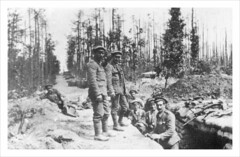 |
Shortly before first light on what
would be a warm, sunny day, at 3.35am on July
20th, the Third Division of the British Army
attacked Delville Wood. Chris McCarthy, in The
Somme Day-by-Day, records that Early
in the morning the Division made an attack on
Delville Wood and village using 2nd Suffolks and
10th Royal Welsh Fusiliers. At 3.35 am the
Suffolks advanced from the west, but the two
leading companies were almost entirely wiped out.
The Fusiliers went astray, and came under fire
from a British machine-gun barrage, losing most
of their officers, only to press home a fruitless
attack.
The casualties in the 2nd Battalion
were heavy, and among those killed in the attack
was Arthur Page. He was 37 years old. It seems to
have been a spectacularly foolhardy action: the
two companies lost no less than ten officers in
the attack, one of them, a Major Congreve, later
being awarded a posthumous Victoria Cross.
 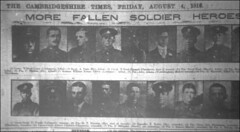 
Arthur's body was recovered,
identified, and buried at Delville
Wood cemetery in Longueval. We visited Albert in
the summer of 2006, but I did not know about
Arthur Page at that time, and so we did not go to
Longueval. We will have to go back.
Arthur's widow Sophia is shown standing
on the far left of my parents' wedding photograph
in 1957. His youngest daughter Phyllis is shown standing on the left
of the middle row on the day I was christened in
1961. He is remembered on the City of Ely war
memorial, the Holy Trinity parish war memorial in
Ely Cathedral, and on the memorial boards in St
George's chapel, also in Ely Cathedral.
Charles Page
Charles Page was my great-great-uncle, the
younger brother of my great-grandfather Arthur Page and an uncle of my
grandmother Phyllis Alice Page, my father's
mother. Born in 1893, Charles was 21 when WWI
broke out. He is mentioned as serving with the
Suffolk Regiment in reports of his brother
Herbert's death, but I have yet to find out more
details.
 Herbert Page Herbert Page
| |
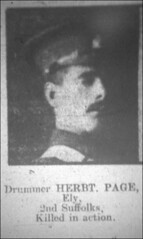 |
|
Herbert Page was my
great-great-uncle, the younger
brother of my great-grandfather Arthur
Page and
an uncle of my grandmother Phyllis
Alice Page, my
father's mother. Here he
is with Arthur on the 1891
census. Herbert signed up on 22nd
July 1900 as a Boy in the Reserve
of the 4th Battalion of the
Suffolk Regiment, when he claimed
to be a month short of his 15th
birthday. In fact, he was 18. The
reason may be that he was just
four feet eight and half inches
tall. His hair was brown, his
eyes were grey, and he had a mole
above his right buttock. He
claimed to be a Wesleyan
Methodist. However, in 1903 he
was punished for being drunk on
duty, and there would be six
further charges of being either
drunk on duty or absent without
leave over the next four years. When
he officially reached the age of
21 in 1907 (in fact, he was 24)
he re-enlisted with the reserve.
Now, he claimed to be a member of
the Church of England, and had a
tattoo on each forearm! He was
assigned to the 3rd Batallion of
the Suffolk Regiment. Herbert
married Eliza Woodbine in 1908 in
Ely. They moved into a house in
Back Lane and had four children
in quick succession. On 5th
February 1909 the Cambridge
Independent Press reported
that Herbert had been found
guilty of drunkenness at Ely
on 1st February. He is
reported to have told the bench
'if you please, can't I go to
Cambridge? That will do me a bit
of good and teach me a lesson.
Then I will try and be better.'
He was sent to prison for seven
days.
Married life seems
to have quietened Herbert down.
He worked as a labourer and
played the drum in the Ely Silver
Band, who performed concerts each
Sunday evening in summer on the
Market Square.
|
On 27th March 2014, as part
of the centenary commemoration, the Ely
Standard published a photograph of
Ely Silver Band on the eve of the First
World War. A diminutive Herbert sits on
the ground far right in the front row:

Herbert was discharged from
the reserve with a good character in
January 1914, but re-enlisted with the
Suffolks as soon as war broke out. A keen
musician, he was a drummer boy in the 2nd
Battalion (12th foot) of the Suffolk
Regiment, the same Battalion as his
brother Arthur. You can read details of
the Battalion's actions in 1915 in the
entry for Arthur (above).
However, Herbert was wounded in October
1915 near Ypres.
He returned to England where
he would spend the next few months
joining the Battalion band. By early
1916, Eliza was pregnant again, but
Herbert was called back to duty in
France. I have heard a story from several
sources that, the night before embarking,
Herbert did the rounds of the pubs of the
Waterside, drumming out a tattoo on the
tables to say goodbye to his friends.
|
It was the last time they would see
him. Returning to Flanders, he was killed on the
2nd of March 1916 at St Eloi, on the Ypres
Salient in Flanders, while engaged in
bomb-throwing duty. He was 33 years old. He is
remembered on the Menin Gate Memorial in Ypres,
as well as on the City of Ely war memorial, the
Holy Trinity parish war memorial in Ely
Cathedral, and on the memorial boards in St
George's chapel, also in Ely Cathedral.
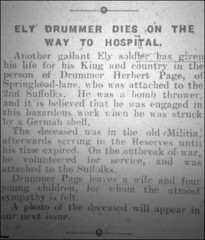 
On the 1st September 1916, almost
exactly six months after his death, Herbert and
Eliza's daughter was born in Springhead Lane,
Ely, home of the Woodbine family. Her name was St
Eloi Souvenir Felixstowe, a grandiloquent name
for a child of the Waterside, but a perpetual
memory of her father's final resting place, and
perhaps a clue to his residence while recovering
from injury the previous year - did Herbert and
Eliza spend time on the Suffolk Coast? St Eloi
was baptised in Holy Trinity parish on the 20th
September 1916, two months to the day after
Herbert's brother Arthur had been killed in the
Battle of the Somme.
Herbert Page's service record
survives up to 1910. Here are some pages from it:
     
    
John Page
John Page was my great-great-uncle, the younger
brother of my great-grandfather Arthur Page and an uncle of my
grandmother Phyllis Alice Page, my father's
mother. Here he is with Arthur
on the 1891 census. John is mentioned on his
brother Robert's service record in a list of
next-of-kin as serving in the Suffolk
Regiment, but I have yet to find out more
details.
Robert Page
Robert Page was a professional
soldier. He was the younger brother of Arthur,
John and Herbert Page. He was my
great-great-uncle, an uncle of my grandmother Phyllis Alice Page, my father's
mother. Here he is with Arthur
and Herbert on the 1891 census. He signed up to
the Suffolk Regiment on April 8th 1902 when he
was 18 years old. He was five feet four inches
tall, his eyes were blue and his hair was brown.
He claimed to be a member of the Church of
England, but on 6th September 1906 his record was
amended because he had become a Wesleyan
Methodist (his brother Herbert made a move in the
opposite direction). In 1905 he extended his
service, joining the 2nd Battalion of the Suffolk
Regiment, becoming a Corporal. He was discharged
in 1910, and the 1911 census shows him as a swine
herdsman living in Norton, Suffolk.
He re-enlisted with the Suffolk
Reserve in 1914, and was shortly after
transferred to the Northamptonshire Regiment. He
was wounded in 1916 and invalided out in 1917
when his discharge papers noted he was fit to
work. He joined the Labour Corps after the War in
1919, being finally discharged as surplus to
military requirements in March 1920, when he
returned to Long Melford in Suffolk to live with
his wife and children. In about 1920, a photograph was taken outside
of Melford Hall of all the local men who had
fought in the War and survived it, and it is
likely that Robert is in this photograph.
More than sixty pages of Robert
Page's service record survive. Here are a few of
them:
     
      
      
Thomas Page
Thomas Page was the younger brother of
Arthur, John, Herbert and Robert Page. He was my
great-great-uncle, an uncle of my grandmother Phyllis Alice Page, my father's
mother. Here he is as a baby
with Arthur and Herbert on the 1891 census. At
the time of the 1911 census he was with the 3rd
Battalion of the Suffolk Regiment, which is to
say the Suffolk Militia, in barracks at Bury St
Edmunds. Thomas was 24 When the
Great War broke out. He was recalled to the 3rd
Battalion, Suffolk Regiment on the 13th August
1914, nine days after war was declared. His medal
record shows that he entered the theatre of
war on the 10th October. The Suffolk Militia
were based at Felixstowe, and seem to have served
mainly as a battalion of men transferred to
supplement the losses of other battalions of the
Suffolk Regiment. If Thomas entered the
theatre of war on the 10th October, then he
was probably one of the recruits sent to France
to bolster the 2nd Suffolks after their losses at
Le Cateau. These men spent most of the rest of
1914 waiting outside of Ypres, and they were
among the troops inspected by George V, an event
described by Henry Williamson in his Chronicle
of Ancient Sunlight sequence. Also described
in vivid detail by Williamson was the Christmas
Truce of 1914, which he witnessed and which
Thomas Page and the 2nd Suffolks would also have
taken part in.
The
early part of 1915 was relatively uneventful for
the 2nd Suffolks, mostly engaged in waiting and
trench digging near to the Menin Road. Thomas's
medal records show that he was discharged on the
25th July 1915, the cause given as sickness -
whatever it was, it was sufficient for Thomas not
to be recalled at the start of general
conscription in 1916, and he appears to have
spent the rest of the War in Ely. It is notable
that Thomas was awarded the roses clasp in 1935.
Recipients had to apply for this, which was awarded to
those who had served under fire or who had
operated within range of enemy mobile artillery
in France or Belgium during the period between 5
August and 22 November 1914.
Robert Reynolds
Robert Reynolds was the younger brother
of my great-grandfather Tom Reynolds. He was my
great-great-uncle, an uncle of my grandmother Winifred Ellen
Reynolds, my mother's mother. When War broke
out, he lived in St Albans in Hertfordshire. On
June 6th 1915, Robert signed up as a Private
soldier with the Remount Squadron of the Army
Service Corps. He was 33 years and 7 months old
and stood 5 feet 4 and a half inches tall. Robert
appears to have served throughout the War at the
depot in Romsey, Hants, the only incident of note
being that he was confined to barracks for 4 days
in 1916 for being absent without leave on parade.
He survived the War to be awarded a pension in
1919.
Frederick
Thomas 'Tom' Reynolds
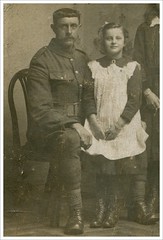 |
|
Thomas Reynolds was my
great-grandfather, the father of my
grandmother Winifred
Ellen Reynolds, my
mother's mother. When the First World War
broke out, he enlisted as a Private
soldier in the 1st Battalion of the
Suffolk Regiment.
The 1st Suffolks were part
of the 28th Division of the Army. The Long Long Trail website records
that the 28th was formed at Hursley,
Pitt Hill and Magdalen Hill Camp near
Winchester in December 1914 - January
1915 and was rushed as a much-needed
reinforcement to France. Shortage of some
types of units were filled by Territorial
units taken from other Divisions. It
embarked at Southampton and landed at Le
Havre on 16-19 January 1915 (Thomas
Reynolds's medal record shows that
his battalion arrived in France six
months later, on the 8th of June) and
then moved to concentrate in the area
between Bailleul and Hazebrouck. The
Division subsequently took part in the
Second Battle of Ypres (but this was
before Thomas Reynolds disembarked) and
the Battle of Loos (where Thomas
probably fought, and where the British
first used poison gas on a large scale). The
Division was ordered on 19 October 1915
to to prepare to sail. The first units
left Marseilles for Alexandria (Egypt)
five days later and all units were there
by 22 November. The Division was then
ordered on to Salonika and completed its
disembarkation on 4 January 1916.
|
The Division spent the rest of the
War in the Eastern Mediterranean, a much safer
theatre than the Western Front in France. The
Reynolds's youngest daughter was named Ruth
Salonika Reynolds in commemoration of where her
father was when she was born. In Thomas's
photograph above, he wears four overseas service
stripes. On returning, Thomas Reynolds and his
family moved to Cambridge, where Thomas took a
job with the Star Brewery on Newmarket Road as a
drayman, delivering Tollemache Ales to pubs in
Cambridge and the surrounding villages. He died
at the relatively young age of 64 in 1944, and
was buried at Dry Drayton.
|

![]()
![]()
![]()
![]()
![]()
![]()
![]()
![]()
![]()
![]()
![]()
![]()
![]()
![]()
![]()
![]()
![]()
![]()